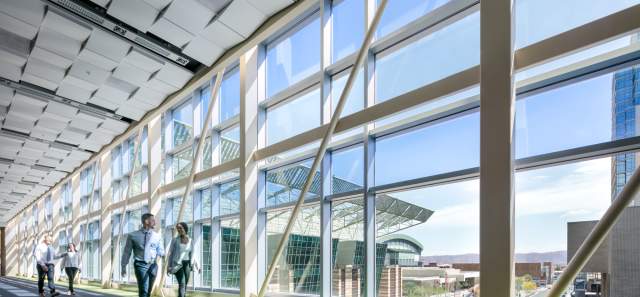Few things beat the thrill of a road trip.
While snacks, playlists and, in some cases, fur babies are essential ingredients for your next outing in the family truckster (Clark Griswold, anyone?), we recommend adding a few stops to explore some of the top hidden gems along the way.
The six-hour jaunt from the LA area to Phoenix is nearly a straight shot that takes you from coast to cactus, with plenty of historic landmarks and stunning scenery and explore in between — as long as you know where to look. Here are six stops to make your next journey just as exciting as the destination.
Before hitting the open road, be sure to check out these fall deals at Greater Phoenix hotels and resorts.
1. The Cabazon Dinosaurs
Some roadside attractions can really withstand the test of time — which, in this case, is about 65 million years. No, seriously, the “world’s biggest outdoor display of prehistoric animals” debuted in 1975 and travelers of a certain age (though, not nearly as old) might recognize the super-sized tyrannosaurus rex and brontosaurus from such cult classics as “Pee Wee’s Big Adventure” and “The Wizard.”
While Mr. Rex's Dinosaur Adventure and the gift shop may be closed in accordance with CDC guidelines, the outdoor dinosaur trail and the photo ops are available seven days a week. Bonus: Stop by Friday through Sunday and treat yourself to a prehistoric-themed ice cream treat from the Wafflesaurus Truck, which is open from 11:30 a.m. to 5:30 p.m.
Hours:
9 a.m. – 7 p.m. Monday through Friday
9 a.m. – 7:30 p.m. Saturday & Sunday
Admission: Adults, $13; children, $11; seniors and military, $10
Address: 50770 Seminole Drive, Cabazon, CA
Contact: 951-922-8700
If you like the Cabazon Dinosaurs, you'll love Pangaea Land of the Dinosaurs at Arizona Boardwalk.
2. Salton Sea State Park
Just about 30 minutes off of I-10 sits the Salton Sea. While the history of this Basin dates back to ancient times, the lake was accidentally created by Colorado River runoff in 1905. The result was considered a "miracle in the desert." In the ’50 and ’60s it's warm water and sandy beaches drew droves of visitors – including Rock Hudson, Frank Sinatra, Jerry Lewis and other Hollywood elites – for a wide variety of recreation and relaxation activities. Hotels, motels, casinos and yacht clubs popped up along the lake’s 116-mile shoreline. But, in the '70s, heavy rain from a series of tropical storms caused the to flood its banks and devastated shoreline businesses and surrounding towns.
While it's nothing like the resort town of decades past, the lake is an important stopover point for migrating birds, it's also the stage for spectacular sunsets and a variety of ever-changing public art (think: small-scale Burning Man set against a post-apocalyptic landscape). Of course, at this point you're asking why would this spot make our list, and the answer is simple: one-of-a-kind photo ops. Just check out Instagram.
Hours: Day use and campground open 24 hours.
Admission: Day use area, $7; campground, $20; boat launch, $5
Address: 100-225 State Park Road, Mecca, CA (north shore)
Contact: 760-393-3059
If you like the views and recreation of this state park, you'll love these Greater Phoenix lakes.
3. Joshua Tree National Park
Although the national park has reopened for the public to enjoy, visitors are encouraged to review the alerts and conditions here.
This national park has the distinction of encompassing two desert ecosystems: the Mojave and the Colorado. The result is a fascinating variety of desert plants, including the park's unmistakeable namesake, and animals — ranging from large herds of desert bighorn sheep and black-tailed jack rabbits to coyotes and kangaroo rats — make their homes in a land sculpted heat, strong winds and occasional torrents of rain.
Visitors can explore 800,000 acres of "dark night skies, a rich cultural history, and surreal geologic features add to the wonder of this vast wilderness," and the park welcomes camping, backpacking, horseback riding, biking, birding, climbing, slacklining, hiking and stargazing. Leashed pets are welcome within 100 feet of roads, picnic areas, and campgrounds.
Additionally, the park is home to significant prehistoric and historic sites and artifacts, including art, shelters, pottery sherds and flaked stone from tool making. The earliest known inhabitants of the park was the Pinto Culture, more than 8,000 years ago.
Hours: Open 24 hours a day, year-round. The visitor centers are open from 8 a.m. to 5 p.m. daily.
Admission: $30 per vehicle
Address: The Joshua Tree Visitor Center is located at 6554 Park Blvd., Joshua Tree, CA. The Oasis Visitor Center is located at 74485 National Park Drive, Twentynine Palms, CA.
Contact: Joshua Tree Visitor Center: 760-366-1855 | Oasis Visitor Center: 760-367-5500
If you like the views and recreation of this state park, you'll love Phoenix's Papago Park.
4. General Patton Memorial Museum
If you find yourself asking what a museum dedicated to General Patton is doing out in the middle of the desert, we have the answer for you: In 1942, the War Department ordered Patton to create a desert training center in California to ready American combat troops for battle in North Africa during World War II.
Today, the museum promotes peace by honoring the service and sacrifice of America’s veterans while educating the public on modern U.S. military history through the preservation and interpretation of artifacts from the major conflicts of the 20th and 21st centuries. Exhibits include a large collection of tanks used in World War II and the Korean War, as well as memorabilia from Patton's life and career, and a Remembrance Wall, memorializing those who have protected our freedom — past and present.
Hours: 7:30 a.m. – 4: 30 p.m. daily
Admission: Adults, $11; seniors and prior military, $9; ages 7-12, $6; ages 6 and under & active duty military, free.
Address: 62-510 Chiriaco Road, Chiriaco Summit, CA
Contact: 760-507-4143
If you like this museum, you'll love the USS Arizona Memorial Gardens at Salt River in Phoenix.
5. Kofa National Wildlife Refuge
Although most refuge lands and outdoor spaces have remained open for the public to enjoy, visitors are encouraged to take the precautions outlined here.
Just over 30 minutes south off I-10, this refuge is a walk on the wild side that’s worth the drive. As the second-largest wilderness area in Arizona (666,640 total acres), 80% of refuge was designated as wilderness under the Arizona Desert Wilderness Act of 1990. This designation plays an important role in ensuring this desert landscape and its inhabitants are protected for future generations.
The refuge — named after the King of Arizona gold mine, which was active from 1897 to 1910 – is home to numerous amphibians and reptiles, a variety of birds and desert mammals – is a sanctuary for such activities as wildlife watching and photography, hiking, camping and limited hunting.
Archaeological research has found remnants, including petroglyphs, of people inhabiting the area as early as 9,000 B.C. And a hike to Palm Canyon, one of the park's most popular areas, reveals scattered clusters of California fan palms — the only native species of palm tree in Arizona — that can be traced back to the last periods of North American glaciation.
Please note: The Visitor Center, open from 8 a.m. to 4:30 p.m. Monday through Friday, is located more than 20 minutes south of the refuge itself.
Admission: Free
Directions: I-10 passes within a few miles of the north edge of the refuge, and the northeast corner is accessed by Vicksburg Road (exit 45), but most approaches are from the west, via side tracks off US 95 between Quartzsite and Yuma.
Contact: 928-783-7861
If you like the natural landscapes and hiking of this refuge, you'll love Phoenix's South Mountain Park and Preserve, one of the largest municipal parks in the country.
6. El Dorado Hot Springs, Tonopah
El Dorado Hot Springs check all the boxes of both a roadside attraction and a hidden gem. Take exit 94 off I-10 and within half a mile, you'll find yourself in the midst of desert oasis. This rustic operation is hidden behind overgrown palms, other flora, fences and weathered decor. But once inside, check-in is low key: You'll likely be greeted by any combination of the peacocks, ducks, chickens and quail, make your payment, get directions to the private soaking pool you reserved (yes, reservations are required) and from there you can pull your car right up to that area.
There are five distinctly different pools to choose from, depending on whether your in the mood for the shady Duck Pond or the sunny Desert Vista. Each area is usually quiet, private, accommodates four to six people and offers chairs for lounging while your not soaking. Less ideal, but still an option, is the common area that hosts variety of smaller tubs in a secluded, but shared space (people are coming and going at their leisure and in whatever attire they deem appropriate for soaking).
Hours: 9 a.m. to 9 p.m. daily
Admission: Private soaking areas, $15 per person (ages 16 and under are free)
Overnight camping, $50 per person ($100 minimum for overnight stay) from 9 p.m. to 9 a.m.
Bunkhouse rentals, $50 per person or $70 per pair from 3 p.m. to 1 p.m.
Address: 41225 Indian School Road, Tonopah
Contact: 623-386-5412
If you like a relaxing soak in a serene scene, you'll love these desert-inspired spa treatments.
YOU MIGHT ALSO LIKE
Hotel & Resort Deals
Celebrate the season with these deals and offers at Greater Phoenix hotels and resorts.
Top Phoenix Attractions
Serene desert gardens, one-of-a-kind museums, award-winning dining and more: Make sure these…
Things to Do in Phoenix This Fall
From museums to outdoor excursions, here are the details on what's open in Greater Phoenix for the…







